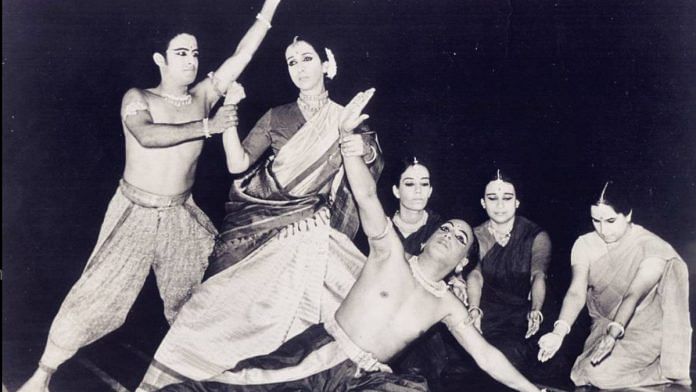Mrinalini Sarabhai was as young as three when she discovered her calling as a dancer. She declared it to her parents, who were extremely supportive even though no one in the family was associated with the performing arts. Born on 11 May 1918 to a liberal family in Kerala, she became one of India’s leading classical dancers and choreographers.
Sarabhai’s work was almost never created in isolation from social issues. One of her most powerful compositions Memory is a Ragged Fragment of Eternity, was based on dowry deaths. In the 1970s she created ‘Ranmalpur,’ a short piece based on the killing of five Dalits in Gujarat.
Known as the doyenne of Indian classical dance, Sarabhai, however, started out with dance lessons in Dalcroze, a Western technique of dance movements. This was during two years of her boarding school in Switzerland. She soon returned to India and enrolled in Santiniketan for three years.
“It is in Santiniketan that she became the aesthete of all things Indian under the tutelage of Rabindranath Tagore,” Mallika Sarabhai, her daughter told ThePrint. Sarabhai’s roommates were former Prime Minister Indira Gandhi, and Kamala Chaudhary, one of the founders of the Indian Institute of Management Ahmedabad.
“Amma says that the minute she walked through the doors, she knew this was home,” said Mallika Sarabhai. He handed her his play Chandalika and asked her to choreograph the dance portion. It was like the entire world was handed to her. She ended up doing all the boys’ roles because Tagore felt she did it even better than them, recalls Mallika.
Also Read: Roshanara — the dancer who took the ‘spirit of central India’ to London, New York
From devadasi to amma
Mrinalini trained in more than one dance form, a rare feat. She learned Bharatanatyam from Meenakshisundaram Pillai, Kathakali from the Guru Kunchu Kurup, and Mohiniattam from Kalyanikutty Amma. She is also credited with being one of the first female performers of Kathakali, breaking the mould of gender-dictated practices.
When Mrinalini moved to Ahmedabad, after her marriage to Vikram Sarabhai, she was seen as a ‘devadasi’. Many lamented the fact that a scientist of Sarabhai’s stature had married a dancer, said Mallika.
The transformation from devadasi to amma took place when Mrinalini started performing in Gujarat and created unique compositions. Ultimately, she established the Darpana Academy of Performing Arts in 1949. It was not just a pioneering step in the field of dance, but also for the emancipation of women as dancing was not yet seen as a respectable pursuit.
One of Mrinalini’s innovative and much-acclaimed choreographic works is Manushya composed in 1958. The Kathakali performance didn’t use the traditionally elaborate costumes and make-up, instead, she emphasised the techniques of hastas (hand gestures) and facial expressions.
She also composed Aspirations, inspired by the movement against the building of the Silent Valley Hydroelectric Project in Kerala. She met many people and explained why trees need not be cut or destroyed. Darpana dancers performed in various villages and cities in Kerala to bring attention to the disaster brought upon them by cutting trees. She also created Ganga to show how the river has been degraded and polluted.
Also Read: How ‘Pasoori’ dancer Sheema Kermani resisted Gen Zia-ul-Haq by wearing ‘un-Islamic’ saris
More than a wife
The release of Rocket Boys, a show that follows the life of her husband Vikram introduced Mrinalini to a whole new audience. But many of them knew her only through the lens of her marriage.
But even her marriage was not conventional for the times they lived in. Mrinalini toured all of Europe, with her oldest child Kartikeya in tow, and delivered one memorable performance after another.
“The relationship between the two [Mrinalini and Vikram] was playful, and there was a deep camaraderie. For the first twelve years of my life, papa was the babysitter and amma was always on tour,’ said Mallika.
Mrinalini did not restrict herself to dance but was a prolific writer. From a novel titled This Alone is True to a textbook Understanding Bharatanatyam, she strived to give back the knowledge of dance she had acquired in her lifetime. She also wrote books for children. In 2004, she released an autobiography, The Voice of the Heart. In his review of the book, cultural critic Sadanand Menon wrote, “Sarabhai’s autobiography fills a gaping lacuna in the story of Indian dance during the past seven decades and should be treated as an important filler in that narrative.”
Despite being a trailblazer, Mrinalini was not without her own set of insecurities and struggles. “Amma grew up with a terrible complex. In Tamil Nadu, she was considered dark and skinny, and that equalled the idea that nobody will marry her,” said Mallika. Added to it was the fact that her elder sister, Lakshmi Sahgal, who served as a captain in Subhas Chandra Bose’s Indian National Army was the opposite.
Also Read: Maya Rao — the woman whose ‘unkept promise’ brought Kathak to south India
Decorated dancer
Mrinalini was the first recipient of the Nishagandhi Puraskaram in 2013, an annual award given by the Government of Kerala to honour those in the fields of dance and music. A year later, she was awarded the Dhirubhai Thakar Savyasachi Saraswat Award by the Gujarat Vishwakosh Trust.
She has also been honoured with both the Padma Shri (1965) and Padma Bhushan (1992). In 1968, she was honoured with a gold medal by the Mexican government for her choreography for the Ballet Folklorico of Mexico.
The essence of her life is also depicted in the 2012 documentary titled The Artist and Her Art directed and scripted by her daughter and Yadavan Chandran.
Mrinalini passed away on 21 January 2016 at the age of 97. In a befitting tribute, her daughter Mallika performed Krishna Nee Begane Baro, a Carnatic composition and a favourite of her mother at the funeral.
(Edited by Theres Sudeep)



